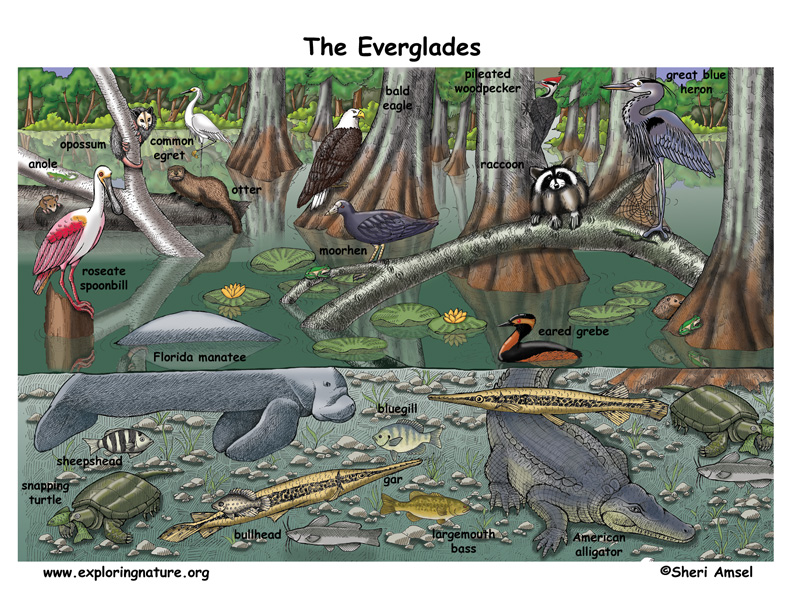

The Everglades are found on the southern tip of Florida.
The Everglades are a four-million-acre sheet of water that flows slowly across a grassy plain – also called the "river of grass."
This rich habitat was once thought to be wasted land. Developers began draining it in the 1800s, pulling up mangroves and replacing them with agricultural crops and citrus groves. They built roads, towns and then giant cities, like Miami – all where this massive wetland once flowed. The Everglades dwindled to half its original size. Sewage and other wastes were freely released from the developed areas into the remaining Everglades. Awareness of the importance of wetlands and specifically the Everglades brought an effort to protect what is left of the river of grass. Scientists began to realize that the Everglades was actually filtering and absorbing pollutants from urban areas, like a natural sewage treatment plant. They also noticed that the Everglades absorbed storm surges during Hurricanes, decreasing dangerous flooding. And people came from all over the world to see this unusual habitat and vast array of Everglades wildlife.
The Everglades is home to many water birds like common egrets, great blue herons, eared grebes, moorhens and roseate spoonbills. There are birds of prey such as the bald eagle, osprey and many hawks. Ther are also woodpeckers like the sizable pileated woodpecker. Water animals, like the Florida manatee, American alligator and river otter do well in the wet habitat, as do scavengers like raccoons and opossums. The water teams with fish like brown bullhead, large mouth bass, bluegill, sheepshead, and spotted sunfish providing lots of food for hungry predators like gar and snapping turtles. This wetland ecosystem is a perfect habitat for insects which feed the many green treefrogs, anoles and other lizards. Even the tiny cotton mouse finds plenty to eat in this rich, diverse habitat.
For Discussion and Critical Thinking:
The Florida Everglades is an important wetland ecosystem.
1. Name two ways the Everglades benefits the communities in Florida.
2. When and why did people begin to drain the Everglades?
3. Name five animals you might see in the Everglades:
_____________________________________________________________________________________________________________
Related Activity:
Everglades Coloring Page
Everglades – Hidden Picture
Related Testing and Assessment:
Everglades - Multiple Choice Quiz
Everglades Read and React Quiz
_____________________________________________________________________________________________________________
When you research information you must cite the reference. Citing for websites is different from citing from books, magazines and periodicals. The style of citing shown here is from the MLA Style Citations (Modern Language Association).
When citing a WEBSITE the general format is as follows.
Author Last Name, First Name(s). "Title: Subtitle of Part of Web Page, if appropriate." Title: Subtitle: Section of Page if appropriate. Sponsoring/Publishing Agency, If Given. Additional significant descriptive information. Date of Electronic Publication or other Date, such as Last Updated. Day Month Year of access < URL >.
Amsel, Sheri. "Florida Everglades" Exploring Nature Educational Resource ©2005-2024. December 14, 2024
< http://www.exploringnature.org/db/view/1753 >

